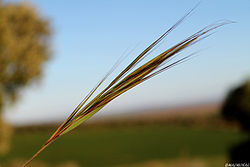| Stipa | |
|---|---|
 | |
| Mediterranean needle-grass, Stipa capensis | |
| Scientific classification | |
| Kingdom: | Plantae |
| Clade: | Tracheophytes |
| Clade: | Angiosperms |
| Clade: | Monocots |
| Clade: | Commelinids |
| Order: | Poales |
| Family: | Poaceae |
| Subfamily: | Pooideae |
| Supertribe: | Stipodae |
| Tribe: | Stipeae |
| Genus: | Stipa L. [1] |
| Species [2] | |
141, see text | |
Stipa is a genus of about 140 species [2] of large perennial hermaphroditic grasses collectively known as feather grass, needle grass, and spear grass. They are placed in the subfamily Pooideae and the tribe Stipeae, which also contains many species formerly assigned to Stipa, which have since been reclassified into new genera.
Contents
Many species are important forage crops. Several species such as Stipa brachytricha, S. arundinacea, S. splendens, S. calamagrostis (now Achnatherum calamagrotis), S. gigantea and S. pulchra are used as ornamental plants. One former species, esparto grass ( Macrochloa tenacissima ), is used for crafts and extensively in paper making.
It is a coarse grass with inrolled leaves and a panicle patterned inflorescence. [3]